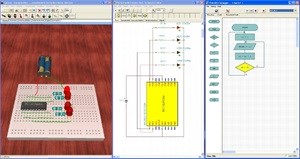Practical work in a virtual world
In some ways, simulation software and virtual labs can be better than traditional pracs. In fact, in his formal review, Prof Dogan Ibrahim, from the Department of Biomedical Engineering at the East University in Cyprus, found many advantages over traditional “real world” experiments, including:
- Real Laboratory equipment is expensive to purchase maintain and update
- Componentry is often damaged, especially by students with little practical experience
- There are safety issues with practical equipment, especially heavy current electrical, which is why instructors always need to be present. This is resource intensive and costly (and highly problematic when the entire university is closed, as is currently the case in Cape Town!)
And cloud computing adds a new dimension – a student can do her practical at almost any location, on almost any device, even on her phone in a coffee shop, while monitoring Twitter to see whether the University has re-opened, or if anyone likes her latest post #coffeepricewaytoohigh.
If simulated online pracs are cheaper and easier, yet still effective in developing those much-needed troubleshooting and problem solving skills, what is the problem? Well, the obvious one: it is not a real world practical. It is not tangible, not hands on. It remains a cyber-prac: a virtual practical, in the sense that it is not quite a practical. (Of course for millennials, the cyber world and the real world are much more intricately entwined than for previous generations – which is why people literally phoned 911 in the US when Facebook went down!) When new interns start at PERT, much of the time in first training is spent specifically on the tangible stuff: this is how you insert the diode, these are the safety features, this is how you calibrate the power meter etc. Dragging and dropping in a new component will never teach you how to properly handle it: its weight, its feel, its delicacy. It can only go so far. So, what to do?
UNISA Physics and PERT are set to try out one solution in 2017: a hybrid system. Students receive a simulation package with their course material and do much of their assigned ‘pracs’ in the virtual world, either by modifying pre-set simulations, or building their own. The virtual experiment helps a student understand the relevance of theory and can translate something abstract into something more concrete. But crucially this is bolstered by traditional ‘hands on’ activities in a dedicated UNISA lab, like the newly built Florida Engineering Lab, where PERT has furnished a large amount of practical training material.
Our hope is that many of the basic skills (like handling componentry) can be picked up quite quickly in the shorter lab sessions, and that the harder cognitive skills of troubleshooting and practical problem solving can be handled in cloud based simulation. Gaps are inevitable. No system is perfect. But this is at least one way in which technology can help make quality education cheaper and more accessible to all South Africans.
For more information on physics and engineering training material please visit www.pert.co.za or mail az.oc.trep@retep
- A very South African skills conference05 Dec 13:19
- Progress in technology has slowed down a lot12 Apr 14:31
- ChatGPT failed a job interview, but I can still put it to work05 Mar 13:13
- How do you make something interesting?07 Jul 14:50
- Business and government - who does it better?14 Nov 10:36



















